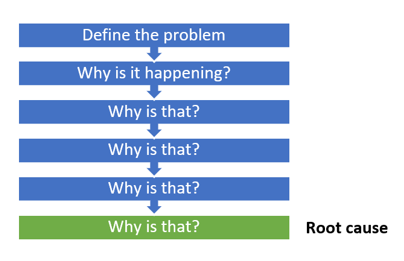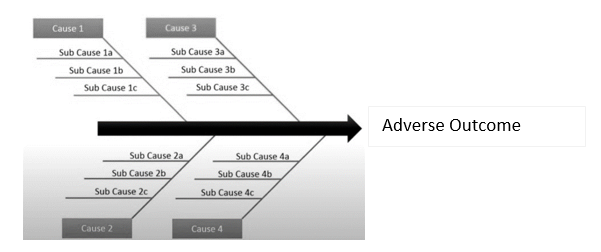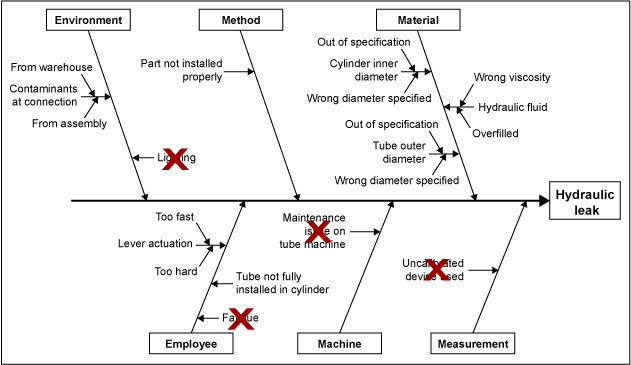10 Which Element Includes the Use of Root Cause Analysis
This element includes a focus on continual learning and continuous improvement. Systemic Actions look comprehensively across all involved systems to prevent future events and promote sustained improvement.

7 Powerful Problem Solving Root Cause Analysis Tools
The RCA is a process for identifying the basic causal factors underlying system failures and is a widely understood methodology used in many industries.

. Using Data to dissolve Problems. What is Root Cause. The Root Cause Analysis Inquiry Guide.
Root causes are underlying causes. An RCA is a specific type of focused review that is used for all patient safety adverse events or close calls requiring analysis. Root Cause Analysis Process Many templates available commercially.
Patient information that is accessible and accurate Drug information that is accessible accurate and usable. The framework and its 24 analysis questions are intended to provide a template for analyzing an event and an aid in organizing the steps and information in a root cause analysis. Feedback data systems and monitoring.
Root causes are those management has control to fix. Fishbone Root Cause Analysis. This element includes a focus on continual learning and continuous improvement.
This category is for all the elements related to the equipment or machines used in the business process. Root cause analysis can be used to uncover factors that lead to patient. Include attributes properties of the harmful outcomes both.
The Twelve Steps of QAPI. Root causes are those for which effective rec-ommendations for preventing recurrences can be generated. Root causes are specific underlying causes.
Identify the root causes A thorough analysis of contributing factors leads to identification of the underlying process and system issues root causes of the event. The most commonly used comprehensive systematic analysis is the Root Cause Analysis RCA. Systems-based RCA originated as a combination of some of the root cause analysis techniques listed above.
2019-2020 Special Education Plan SEP Edition is best utilized by a diverse group of educators encompassing various roles and responsibilities eg special education director general education administrators special education teachers CAASPP. Nition of root cause we use the following. This element includes a focus on continual learning and continuous improvement.
Root Cause Analysis RCA Step-By-Step Guide RCA is a process for identifying the basic or contributing causal factors that underlie variations in performance associated with adverse events or close calls. This methodology is an approach that combines two or more methods of RCA. Systemic Actions look comprehensively across all involved systems to prevent future events and promote sustained improvement.
The goal of root cause analysis is to find out. Structured approach Team involvement Often involve reconstructing event or establishing a timeline of preceding events Includes conclusions recommendations. Why an event occurred.
October 3- 7 2016. School Leaders Guide to Root Cause Analysis. The use of Root Cause Analysis.
Failure-based RCA is used in engineering and maintenance to determine the root cause of any type of equipment failure. The Joint Commission has a very involved template for use in complex situations. Additionally facilities will be expected to develop policies and procedures and demonstrate proficiency in the use of Root Cause Analysis.
A combination of the risk priority number elements of consequence and occurrence used to determine the relative risk of a failure mode and effects analysis item. Sub-categories are included to find the effects of the causes also known as sub-causes. A systematic procedure that uses the results of the other analysis techniques to identify the predominant cause of the accident.
Which element of QAPI includes identifying reporting analyzing and preventing adverse events and near misses. Failure mode and effects analysis. Root causes are those that can reasonably be identified.
Materials defective raw material Man Power lack of knowledge or skill MachineEquipment defective equipment or tools Environment orderly workplace physical demands of the task Management poor management involvement stress demands. The Joint Commissions Framework for Root Cause Analysis and Action Plan provides an example of a comprehensive systematic analysis. Dan Fauchier CMF Kyle Martinez.
Elements of Data Evidence. Basic elements of a root cause are divided into different categories with examples of each in parentheses. If two cause categories have the same sub-causes that must be depicted in the diagram as well.
When performing a root cause analysis the following 10 key elements 7 that affect the core medication use steps should be thoroughly evaluated to determine the cause of the error. Rather than assume knowledge of what a. The use of Root Cause Analysis.
Design and implement changes to eliminate the root causes The team determines how best to change processes and systems to reduce the likelihood of another similar event.

7 Powerful Problem Solving Root Cause Analysis Tools

Root Cause Analysis Tracing A Problem To Its Origins By Tahmina Naznin Cybridge Geeks Medium

No comments for "10 Which Element Includes the Use of Root Cause Analysis"
Post a Comment